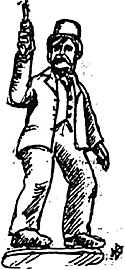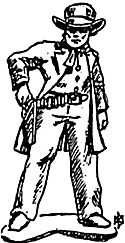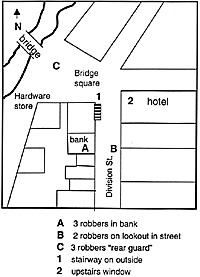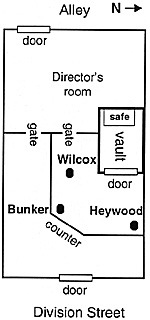[originally published in LW 79]
 Jesse James is a hero to some people but not the citizens of Northfield, Minnesota. When he and his gang tried to rob the bank in Northfield, they killed two members of the gang and drove the rest off empty handed. For the next two weeks, aroused citizens of Minnesota hunted down the bandits, killing or capturing all but two. Hollywood has used the story several times, usually with drama replacing facts. What follows is an attempt to correct some misinformation and perhaps provide a basis for a solo skirmish game.
Jesse James is a hero to some people but not the citizens of Northfield, Minnesota. When he and his gang tried to rob the bank in Northfield, they killed two members of the gang and drove the rest off empty handed. For the next two weeks, aroused citizens of Minnesota hunted down the bandits, killing or capturing all but two. Hollywood has used the story several times, usually with drama replacing facts. What follows is an attempt to correct some misinformation and perhaps provide a basis for a solo skirmish game.
I have seen my share of Jesse James movies, so I knew about Northfield’s history when my employer offered to send me there for training. One afternoon during a lull in the program, I visited the bank, which is now a museum, and measured some of the streets. It was in the bank that I found George Huntington’s book Robber and Hero: the Story of the Northfield Bank Raid. It is a careful reconstruction of the events in Northfield. It differs from other accounts in some ways, like which bandits went into the bank, but I believe it is more reliable. It is based on interviews of eye-witnesses and on some points Huntington admits he doesn’t know. Honesty like that adds credibility.
On September 7th, 1876, the town of Northfield had about 2000 inhabitants. It was in the middle of a farming region and was home of two colleges, St. Olaf and Carleton. The citizens were not expecting a raid, but were hardly defenseless. Many owned firearms for hunting, and the hardware store stocked shotguns and rifles. A few relics of the Civil War were resting in nearly forgotten corners. More important, several men had a cool courage in emergency that would serve them well.
The James gang was made up of eight men, Jesse and Frank James, the Youngers: Cole, James and Robert, Clel Miller and Charlie Pitts. They had been traveling through Minnesota posing as businessmen. They would drift into town in twos and threes. One group ate lunch in town before the robbery. They were mounted on excellent horses and wore long linen dusters to cover the fact that they wore revolvers.
 Their target was the bank on Division Street (see map). They had selected it after deciding that the bank in Mankato, Minnesota, was too risky, too many people around it. The group I have labeled (A) on the map rode in, tied their horses in front of the bank and waited. Charles Pitt, Robert Younger and one of the Jameses entered the bank as group (B) and took their position in front of the bank. Cole Younger and Clel Miller served as lookouts. Group (C) including James Younger, William Stiles and the other James took a position at Bridge Square. This let them support the group on Division Street and keep an eye on the bridge, which was their escape route.
Their target was the bank on Division Street (see map). They had selected it after deciding that the bank in Mankato, Minnesota, was too risky, too many people around it. The group I have labeled (A) on the map rode in, tied their horses in front of the bank and waited. Charles Pitt, Robert Younger and one of the Jameses entered the bank as group (B) and took their position in front of the bank. Cole Younger and Clel Miller served as lookouts. Group (C) including James Younger, William Stiles and the other James took a position at Bridge Square. This let them support the group on Division Street and keep an eye on the bridge, which was their escape route.
The trouble began about 2:00 p.m. A medical student named Wheeler tried to enter the bank and was stopped by Clel Miller. Wheeler yelled “Robbery! Robbery!” and ran to a nearby hotel to search for weapons. J.S. Allen started for the bank and was stopped by Miller. He ran to his hardware store and began handing out weapons to aroused citizens. Wheeler found an old breech-loading Civil War rifle and took a position on the second floor of the hotel (see [2] on the map). The hotel is no longer standing, so my position is a rough approximation. From this position he fired a shot at James Younger and missed. His next shot killed Clel Miller. Then he was out of paper cartridges.
A citizen named Manning brought a breech loading rifle from the hardware store to the corner of Division Street. First he shot a horse and then his rifle jammed. He went back, got a ramrod, cleared the weapon and returned to the corner. His next shot was deflected but wounded Cole Younger. By now several citizens were firing. They were handicapped by the fact that they mostly had shotguns loaded with birdshot. Clel Miller was initially hit with birdshot but not seriously hurt. Two citizens were throwing stones!
Inside the bank the robbery was failing. None of the three employees would open the safe. In fact the safe was unlocked, but this secret was protected by the three men. The bandits beat on the cashier J.L. Heywood’s head. They threatened to cut his throat and even fired a gun near his head. He would not cooperate. A.E. Bunker tried for a revolver on a shelf, but Charlie Pitts shot him in the shoulder. By now it was clear that something was wrong outside. The bandits started to leave. Heywood got up and started toward them and one of the robbers shot and killed him.
By now the street was a noisy violent place. The bandits had mounted and were spraying shots around trying to terrify the citizens. They only hit one man, an immigrant who may not have understood repeated yells to “get off the street.” Bob Younger came out of the bank to find his horse dead. He drew his gun and advanced toward the corner of Division Street where Manning was shooting. Manning had fired a deliberate shot through the heart of William Stiles. Now he faced Bob Younger, who hid behind the staircase outside the building. As Manning and Younger ducked behind cover each tried to see the other. Wheeler, who had been given more cartridges, fired a shot that shattered Bob Younger’s right elbow. Younger shifted his revolver to his left hand. By now the outlaws were ready to retreat. Cole Younger pulled Bob up behind him and the gang rode off across the bridge and out of town.
Each September, Northfield holds a festival called “Defeat of Jesse James Days” during which they re-enact the attempted robbery. The bank has been restored and serves as a museum where the tourists can even see an actual bandit, a skeleton reputed to be that of Charles Pitts.
Wargame Notes
The eight bandits could be played as programmed to carry out their plan. They were each armed with one or more revolvers. The museum has a long barreled Colt single action Army revolver which it claims was owned by one of the Younger brothers. There is also a Smith and Wesson .44 Russian revolver on display. The third gun in the case is an old cap and ball revolver that has been reworked to fire cartridges.
Gamers could let chance decide the number and position of the citizens who fight. The hardware store and some homes held firearms. My estimate would be 70% shotguns, 30% rifles. Maybe 5% pistols or revolvers would be in some of the places with other guns. Shotguns shoot birdshot. These would be hunting guns, not sawn off.
My map of the street and buildings is based on pictures of 1876 and current street maps. Some buildings are still standing from those days. Pictures and dates on current buildings indicate that many buildings on Division Street were wooden. The bank, hotel, and building next to the bank and facing Bridge Square were all brick. Bridge Square is an open place planted with flowers. An old bridge still spans the Cannon River.
It’s a peaceful scene, a quiet midwestern college town, the kind Hollywood would select for the locale for a college-based comedy like “Bedtime for Bonzo,” not the site of a western shootout.
Maps
 |
|
Related
Back to Table of Contents -- Lone Warrior #137
Back to Lone Warrior List of Issues
Back to MagWeb Magazine List
© Copyright 2002 by Solo Wargamers Association.
This article appears in MagWeb (Magazine Web) on the Internet World Wide Web.
Other military history articles and gaming articles are available at http://www.magweb.com

